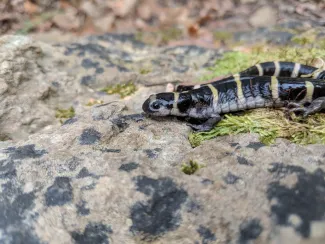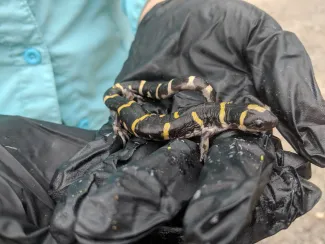Less than an inch of rain fell from 2 to 7 p.m. on Oct. 9, 2018, but it was enough to prompt 196 ringed salamanders to emerge from their underground homes and embark on their annual journey to a small, fishless pond in the Ozark Plateau region.
“These salamanders really only come aboveground for a short period of time – typically during fall rains – and their main goal during that time is to court and lay eggs,” said Taylor Carlson, graduate research assistant studying the geographic distribution of the rare salamander for Oklahoma State University.
Fall rains add water to existing ponds, creating ideal conditions for these amphibians to breed and deposit their eggs. Within a few weeks, the eggs hatch and the larval salamanders overwinter in the pond before transforming into terrestrial adults.

Breeding activity typically only lasts a few days at an individual site but can occur from late August to November, depending on rainfall timing and amounts. After mating, the adults leave the ponds and return to underground burrows where they often remain for the rest of the year. A limited number of ringed salamanders have been documented as part of spring reptile and amphibian surveys.
Carlson only recently began her study of the salamander but has already found more adults in Oklahoma than have been scientifically documented in our state’s history.
Ringed salamanders have a closed season in Oklahoma and cannot be captured or handled without a valid Scientific Collector’s Permit, issued by the Oklahoma Department of Wildlife Conservation.
“So far, we’ve focused searches around four ponds in the region. The weather conditions and timing of searches have been perfect. We’ve collected data on more than 500 individual salamanders in only a week’s time.”
“Not many people have had the opportunity to see the migration of ringed salamanders to breeding ponds, and this is the first time a mass migration of these amphibians has been documented in Oklahoma. These salamanders are coming out in the middle of the night, in the middle of a rainstorm, and very few people have searched under those conditions in Oklahoma.”

Carlson’s team officially kicked off their first field season in September 2018 and found the project’s first salamander later that month.
“We were so excited to find a large female underneath a rock near a small pond. Experiencing a mass migration only a few weeks after finding the project’s first individual was a great feeling.”
In addition to documenting the salamander’s locations, Carlson’s team is also interested in testing different methods that could allow for the identification of individual salamanders.
“We’re taking photographs of each salamander; one photo of the entire back and one close-up from hip to shoulder. We need to run the photos through the software program, but it’s possible that we’ll be able to document individuals returning to a pond next year with these individual-specific photographs.”
Elastomer dyes that fluoresce under black light are also being tested on a subsample of the salamanders in case the photographs aren’t able to accurately identify the salamanders on an individual basis. This will provide Carlson’s team with another way to document individual salamanders returning to the same pond in future breeding migrations and to estimate population size.
For now, Carlson is determined to find more salamanders in as many locations as possible.
“It’s the slimiest Easter egg hunt I’ve ever been on.”
Update:
Carlson’s teams surveyed ponds in the Ozark Uplift and Ouachita Mountains from 2018-2022 and captured 2,401 individual adult ringed salamanders in Oklahoma. More than 60% of the captures occurred in the Ozarks, and the biggest capture night, Oct. 28, 2020, yielded nearly 250 captures from seven Ozark survey sites. More than half of the individuals captured during the five-year study were male, and the average length was just over 3.5 inches.
Only 43 individuals that were uniquely marked with the elastomer dyes were captured more than once, and most of those salamanders were recaptured in the same pond in which they were first detected. This indicates that individual salamanders may be tied to individual ponds, making the conservation of these small, scattered ponds important to the conservation of the species. Because so few of the many captured animals were detected during the second and third rounds of surveys, this small number of recaptures also indicates that local populations can be very large.
This project is funded in part by ODWC’s State Wildlife Grants Program Grant F18AF00380 and by Oklahoma State University.